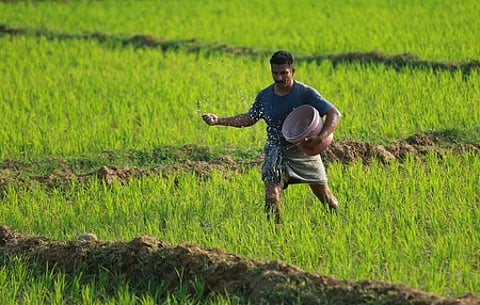

NEW DELHI: Most of the states in India failed to achieve the goal to double farmers' incomes (DFI) by the 2022-23 period, a target set by the Narendra Modi government in 2016-17.
However, Bihar, Uttarakhand, along with the Union Territories, have successfully achieved this goal.
This information was revealed in a new policy paper titled “Doubling Farmers’ Income: A Promising Target Fraught with Challenges,” released by former Union Agriculture Secretary Siraj Hussain.
The analysis indicates that India has fallen short of the DFI goal by 25 per cent. Furthermore, the contribution of the farm sector to doubling farmers' incomes has decreased compared to the non-farm sector.
In 2016-17, the Indian government set the goal of doubling farmers’ total income by 2022-23, using 2015-16 as the baseline year.
The study extrapolated farmers' income from 2018-19 to 2022-23 and compared it with the government’s target. It showed that only two states—Bihar and Uttarakhand—and the combined North-eastern states achieved the target.
The study suggests that the possibility of attaining DFI in the near future is higher in states like Andhra Pradesh, Assam, Chhattisgarh, Gujarat, Jammu and Kashmir, Maharashtra, and Rajasthan, as these states have registered income growth trends ranging from 20% to 50%.
However, the study emphasizes the slim chances of achieving the DFI goal in five states: Jharkhand, Madhya Pradesh, Odisha, Punjab, and West Bengal.
Madhya Pradesh, in particular, has shown minimal growth, largely due to negligible increases in gross state domestic product in agriculture and allied activities (GSDPA) from 2018-19 to 2019-20.
Nevertheless, there is a silver lining as Madhya Pradesh has recently reported an average GSDPA growth of nearly 7%, indicating substantial growth potential, according to the study.
Overall, the study highlights distress in agricultural growth. The increase in income from wages, salaries, and non-farm businesses suggests that the non-farm sector has performed better than the farm sector in several states.
The study also found that direct relationship between farm size and income.
India has 86% small and marginal farmers who need special attention to increase income. Further, inter-state and social disparities in income remain wide.
The income of farmers of Punjab and Haryana is almost five times more than that of farmers in Bihar and West Bengal.
Similarly, the income gaps between large and marginal farmers and SC-ST and OBC-Other caste farmers remain wide. The policy paper was prepared by a group of economists and sector experts, Seema Bathla, Anjani Kumar, Navneet Kumar, and Siraj Hussain.
The study has examined the last two decades' trends, composition, and growth in farmers’ total net income between 2002–03 and 2018–19 across the states to assess the possibility of DFI.
It also analyses the increment in income whether equitable and inclusive.
The data is based on National Sample Survey- Situational Analysis Survey (NSS-SAS) undertaken during 2002–03, 2012–13 and 2018–19.